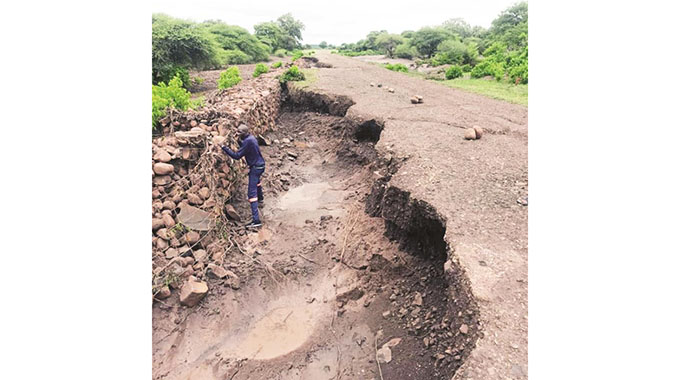Editorial Comment: Let’s manage impact of rains on infrastructure

Much of Zimbabwe is enjoying normal to above normal rains so far this season with farmers, for once, happy as they see their crops grow, pastures flourish, cattle grazing well and water sources filling.
And basically they want this to continue until the end of the season, so they get a good harvest, have enough pasture until the next rains, can see wetlands revived, streams flowing and dams filling. If you are planning on irrigation this winter it is pleasant to know that the water is just there.
But there are some, normal, downsides. Rivers do rise in flood, so there are delays at some bridges and fords, a closure of short cuts and a need to go the long way round.
Side roads in some areas, perhaps where a rural district council has not been fanatical about maintenance during the last two drought seasons, have been damaged. And, as usual, a handful of people have taken a chance on where they build and now have water lapping around their door.
As we have already seen with tropical storm Chalane, and now a potential threat from tropical storm Eloise which is moving over the northern tip of Madagascar on its westwards journey, the “cyclone season” in the south west Indian Ocean can generate potential threats that have to be planned for and then managed.
There are up to a dozen of these each season. Few reach Zimbabwe and most, when they do, are not of the most destructive intensity. But global warming means we can see more and in any case we need to be properly prepared well in advance with a standard set of procedures that can be activated as needed.
As usual in urban areas, there are some people who ignored their storm water drains, some who even filled them to make a nice roadside garden, and some in new housing areas who never bothered to have them dug properly in the first place. A bit of digging is normally the required remedial action.
Chalane showed that we were ready for a cyclone. While, like most of these storms, it in the end was hovering around the borderline between tropical storm and tropical depression, it did give our emergency services under the coordination of civil defence, and the warned communities, a good “live fire” practice run to see if we had adequately upgraded our responses and put in the proper warning and reaction systems.
While very few people had to be evacuated, and while damage to roads was minimal, we had the local leadership in the forecast most seriously affected areas properly briefed and warned.
We had designated shelters, usually schools and especially boarding schools, which all do have sanitation, ready. But churches and earthmoving companies also said they were ready to help if needed.
Emergency supplies were prepositioned, along with the required emergency teams to reopen any closed roads or even throw up temporary bridges. The Air Force of Zimbabwe put helicopters on alert, buses were ready to move communities if evacuation was ordered.
Even Zesa had teams ready to respond should falling trees, poles or branches cause power cuts.
So generally we were well prepared. The fact that Chalane diminished quickly, and even as it swept across a swathe of Zimbabwe on its way to Botswana brought little, but heavier rain in its wake, should not make us complacent, but nor should a cyclone threat terrify us.
We are ready and we just have to stay ready.
The same readiness is however needed to cope with normal to above normal rains, and the long line of poorer seasons has shown some gaps. The good rains have highlighted the need for district rural councils in particular to take their responsibilities for road and bridge maintenance very seriously.
There have been reports of washaways on a few roads, which means that storm water drainage was not up to scratch. But in any case most councils need to keep the basic road maintenance equipment ready as storms arrive.
This is not complex, but every council needs at least one grader and a truck and might need to hire some temporary workers when quick repairs are required. Councils also need to do drudgery of year-round upgrading; the time to really fix a road is in the dry season.
We need to remember with farmers getting better training and inputs on time, we are going to need more trucks on even the most remote rural roads to haul away the harvest.
The Zimbabwe National Roads Administration tried around three years ago to help rural district councils plan for this, with a scheme so they could buy a grader each on terms.
Some grabbed the opportunity, but some gave it too low a priority. All now need to think carefully. Government has made a large budget for devolution grants, and this basic equipment should be high on each council list.
Temporary bridges are neither expensive nor difficult if a bridge is damaged. One of the best is the old Second World War Bailey Bridge, made up of prefabricated steel sections and wooden stringers that can be carried in a truck, erected in hours without cranes or other complex equipment and is strong enough to carry a tank.
A decent Zimbabwean engineering firm, which can cut the right sort of steel sections precisely, could easily make up the 3m sections with little trouble. A small group of people would need to be trained to manage the gangs of temporary workers to manhandle the parts. Modest stores of prepositioned sections seem a good idea.
At the same time, councils, communities, schools and even individual farmers should be putting in more simple permanent bridges over smaller streams.
A simple design works, and plans and lists of required materials can be made readily available. Even a small stream often cannot be crossed, or crossed safely, for a couple of months in the rains so these are needed and often can be funded from local resources.
MPs looking to spend constituency grants could keep a list.
Droughts might be more frequent, but they should not be considered “normal”, and in any case new farming techniques, crops and varieties, along with more irrigation and water conservation, mean that we can cope better with too little rain as much as we need to cope with above-normal rains. It just needs thinking and the “can do” culture.








Comments